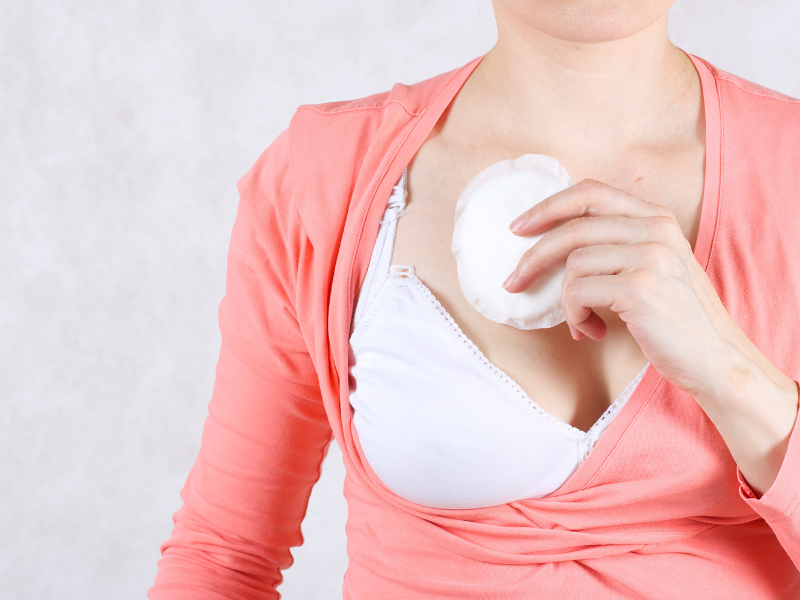If you’re breastfeeding and dealing with leaking breasts, you’re definitely not alone—and yes, it can be frustrating. That unexpected trickle (or gush) of milk can hit at the worst times: during a meeting, in the middle of the night, or just when you finally get dressed for the day. The good news? It’s completely normal. Over 60% of new moms experience it. Even better: there are easy ways to manage it and feel comfortable again.
What Is Breast Milk Leakage (BML)?
Breast milk leakage (BML) happens when milk leaks out of your breasts—usually without warning. Some women leak a lot, some only leak on one side, and others don’t leak at all. While it can feel embarrassing, it’s extremely common and doesn’t always mean you have too much milk. Even moms struggling with supply can leak milk. Leaking isn’t a reliable sign of how much milk you’re making.
What Causes Leaking Breasts?
Here are the most common triggers for breast milk leakage:
- Let-Down Reflex: This natural reflex releases milk and can be triggered by your baby crying, thinking about feeding, or even cuddling. Some women even leak during intimacy, thanks to a hormone called oxytocin.
- Full or Engorged Breasts: If you wait too long between feeds, your breasts can get too full and start leaking.
- Oversupply Can Cause Breast Milk Leakage: Making more milk than your baby needs can lead to regular leaking.
- Warm Showers: The heat can stimulate your let-down reflex.
How to Manage Leaking Breasts
Let’s keep it simple. Here are practical, mom-tested ways to manage leakage:
- Wear nursing pads daily: Nursing pads—disposable or washable—help absorb leaks and protect your clothes. Always keep a few in your diaper bag or purse.
- Feed often or hand express a little: Try not to let your breasts get overly full. Nursing more frequently or hand expressing a bit of milk can relieve pressure and reduce leaks.
- Apply gentle pressure when needed: Cross your arms and hug your breasts tight, or press gently on the nipple area. This can stop a leak in its tracks when you’re in public or between feeds.
- Use cold compresses: Cold packs can help calm your breasts and reduce both swelling and milk flow. Great after a feed or when you’re feeling engorged.
- Avoid unwanted stimulation: If you notice certain things trigger leaking—like warm showers or vigorous exercise—try to time them after a feed when your breasts are lighter.
- Catch and store the milk: If one breast leaks while feeding from the other, use a milk catcher or breast shell to collect the milk and store it. Some moms freeze their collected milk for future use. The Milk Saver by Milkies is a popular option for this.
- Dress for confidence: Dark shirts, extra layers, or a lightweight scarf can make surprise leaks less noticeable. Carry an extra top just in case.
- Prep for nighttime: Leaking doesn’t stop when you sleep. Line your bra with nighttime pads or lay a towel on your bed to protect your sheets.

When Leaking Lasts Longer Than Expected
Most moms who leak notice it easing up by about 8 weeks postpartum. For others, it can continue up to 6 months. And in rare cases, a few moms have reported leakage up to three years after weaning.
Leaking Breasts & Oversupply
If your leaking is paired with a strong let-down, constant fullness, or your baby seems to struggle with milk flow, it could be a sign of oversupply. Some simple adjustments can help:
- Offer one breast per feed
- Try feeding in a reclined position
- Avoid over-pumping, which can tell your body to make even more milk
- Get more oversupply tips here
Not sure what’s going on? A lactation consultant can guide you.
Don’t Waste It—Donate It
If you’re collecting more milk than your baby needs, consider donating it to a breast milk bank. These banks screen donors and distribute safe, pasteurized human milk to babies in need. Your extra milk could help another child get a strong immune start.
Final Thoughts on Leaking Breasts
Leaking breasts are one of those things that many breastfeeding moms deal with, but nobody really talks about. You’re not alone—and you’re not doing anything wrong. With a little planning, the right gear, and some grace for yourself, you can manage leaking breasts without letting them run your day.
This phase is temporary. You’ll get through it. You’ve got this.
Resources
- Find a breastfeeding support group near you.
- Milkology Breastfeeding Class – Affordable, video-based online course to help you master breastfeeding at your own pace.
References
- Leaking: A Problem of Lactation — Journal of Nurse-Midwifery (1989) In this study, 66% of women were still experiencing leaking at six months postpartum. Leaking was most common in the early weeks, and nearly universal immediately postpartum.
- Leaking breasts — Australian Breastfeeding Association (June 2025) This is a practical resource explaining why leaking happens, typical patterns (especially early days), and management strategies (pads, pressure, milk catchers) from a reputable breastfeeding organisation.
- Breastfeeding – Leaking breasts (oversupply) — HSE.ie (20 Aug 2022) This government‑health website describes leaking as connected to oversupply, offers short‑term tips (cold compresses, cabbage leaves, frequent feeds) and when to seek help.
- Too much breast milk? How to reduce oversupply — Medela (Mar 1 2021) This brand‑education page outlines that leaking does not always mean oversupply, and offers strategies (laid‑back feeding, minimal expression, nursing pads) for oversupply situations.


